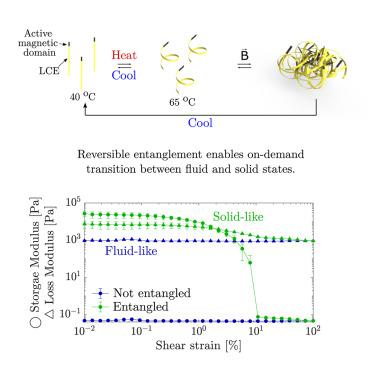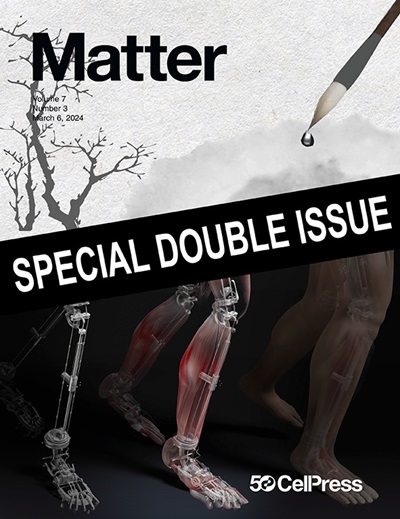磁活性液晶弹性体带的集体作用和纠缠
IF 17.5
1区 材料科学
Q1 MATERIALS SCIENCE, MULTIDISCIPLINARY
引用次数: 0
摘要
动物集体中活跃个体之间的相互作用导致了在合成软物质中仍然难以捉摸的紧急反应。在这里,形状变形聚合物用于创造仿生瞬态固体,这些固体可以自组装,具有可控的机械性能,并根据需要拆卸。磁性热响应液晶弹性体带的稀悬浮液机械互锁,诱导可逆聚集。建立了一个数学模型,揭示了拓扑机制在聚合中的作用。与平坦带或高曲率带相比,中等曲率带更有利于聚集。带状悬浮液在流体和固体状态之间可逆地转变,与液体分散体相比,纠缠聚集体的存储模量增加了6个数量级。受控解离是通过在高磁场旋转速度(>3.33 Hz)下向单个条带传递动能来诱导的。将动态的集体行为引入合成系统可能会使从仿生软机器人到可注射生物材料的潜在应用成为可能。本文章由计算机程序翻译,如有差异,请以英文原文为准。


Collective action and entanglement of magnetically active liquid crystal elastomer ribbons
Interactions between active individuals in animal collectives lead to emergent responses that remain elusive in synthetic soft matter. Here, shape-morphing polymers serve to create bio-inspired transient solids that self-assemble with controlled mechanical properties and disassemble on demand. Dilute suspensions of magnetic, heat-responsive liquid crystal elastomer ribbons mechanically interlock, inducing reversible aggregation. A mathematical model is developed that sheds light on the role of topological mechanisms in aggregation. Aggregation was favored for ribbons with moderate curvature as compared to flat ribbons or higher-curvature ribbons. The ribbon suspensions reversibly transition between fluid- and solid-like states, exhibiting an increase of up to six orders of magnitude in the storage moduli of the entangled aggregates compared with the liquid dispersions. Controlled dissociation is induced by imparting kinetic energy to the individual ribbons at high magnetic-field rotation speeds ( Hz). Imparting dynamic collective behaviors into synthetic systems may enable potential applications from bio-inspired soft robotics to injectable biomaterials.
求助全文
通过发布文献求助,成功后即可免费获取论文全文。
去求助
来源期刊

Matter
MATERIALS SCIENCE, MULTIDISCIPLINARY-
CiteScore
26.30
自引率
2.60%
发文量
367
期刊介绍:
Matter, a monthly journal affiliated with Cell, spans the broad field of materials science from nano to macro levels,covering fundamentals to applications. Embracing groundbreaking technologies,it includes full-length research articles,reviews, perspectives,previews, opinions, personnel stories, and general editorial content.
Matter aims to be the primary resource for researchers in academia and industry, inspiring the next generation of materials scientists.
 求助内容:
求助内容: 应助结果提醒方式:
应助结果提醒方式:


